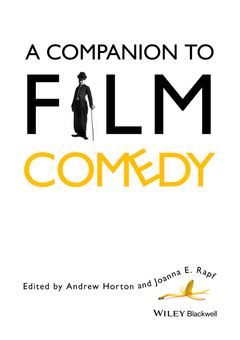Description
A Companion to Film Comedy
Language: English
Keywords
film history, cinema history, scholarship, reference, comic films, European comedy films, Middle East comedy films, Korean comedy films, slapstick, romantic comedy, romcom, satyre, satirical, ironic, Nativ American comedy films, gender and comedy, politics and comedy, screwball comedy, buddy film, comedy genre, film genre, Hollywood, Hong Kong, film directors
Publication date: 12-2015
584 p. · 17x24.4 cm · Paperback
Publication date: 12-2012
584 p. · 18.2x25.5 cm · Hardback
Description
/li>Contents
/li>Biography
/li>
- A wide-ranging collection of 24 essays exploring film comedy from the silent era to the present
- International in scope, the collection embraces not just American cinema, including Native American and African American, but also comic films from Europe, the Middle East, and Korea
- Essays explore sub-genres, performers, and cultural perspectives such as gender, politics, and history in addition to individual works
- Engages with different strands of comedy including slapstick, romantic, satirical and ironic
- Features original entries from a diverse group of multidisciplinary international contributors
Comic Introduction: “Make ’em Laugh, make ’em Laugh!” 1
Part I Comedy Before Sound, and the Slapstick Tradition
1 The Mark of the Ridiculous and Silent Celluloid: Some Trends in American and European Film Comedy from 1894 to 1929 15
Frank Scheide
2 Pie Queens and Virtuous Vamps: The FunnyWomen of the Silent Screen 39
Kristen Anderson Wagner
3 “Sound Came Along and OutWent the Pies”: The American Slapstick Short and the Coming of Sound 61
Rob King
Part II Comic Performers in the Sound Era
4 Mutinies Wednesdays and Saturdays: Carnivalesque Comedy and the Marx Brothers 87
Frank Krutnik
5 Jacques Tati and Comedic Performance 111
Kevin W. Sweeney
6 Woody Allen: Charlie Chaplin of New Hollywood 130
David R. Shumway
7 Mel Brooks, Vulgar Modernism, and Comic Remediation 151
Henry Jenkins
Part III New Perspectives on Romantic Comedy and Masculinity
8 Humor and Erotic Utopia: The Intimate Scenarios of Romantic Comedy 175
Celestino Deleyto
9 Taking Romantic Comedy Seriously in Eternal Sunshine of the Spotless Mind (2004) and Before Sunset (2004) 196
Leger Grindon
10 The View from the Man Cave: Comedy in the Contemporary “Homme-com” Cycle 217
Tamar Jeffers McDonald
11 The Reproduction of Mothering: Masculinity, Adoption, and Identity in Flirting with Disaster 236
Lucy Fischer
Part IV Topical Comedy, Irony, and Humour Noir
12 It’s Good to be the King: Hollywood’s Mythical Monarchies, Troubled Republics, and Crazy Kingdoms 251
Charles Morrow
13 No Escaping the Depression: Utopian Comedy and the Aesthetics of Escapism in Frank Capra’s You Can’t Take it with You (1938) 273
William Paul
14 The Totalitarian Comedy of Lubitsch’s To Be or Not To Be 293
Maria DiBattista
15 Dark Comedy from Dr. Strangelove to the Dude 315
Mark Eaton
Part V Comic Perspectives on Race and Ethnicity
16 Black Film Comedy as Vital Edge: A Reassessment of the Genre 343
Catherine A. John
17 Winking Like a One-Eyed Ford: American Indian Film Comedies on the Hilarity of Poverty 365
Joshua B. Nelson
18 Ethnic Humor in American Film: The Greek Americans 387
Dan Georgakas
Part VI International Comedy
19 Alexander Mackendrick: Dreams, Nightmares, and Myths in Ealing Comedy 409
Claire Mortimer
20 Tragicomic Transformations: Gender, Humor, and the Plastic Body in Two Korean Comedies 432
Jane Park
21 Comedy “Italian Style” and I soliti ignoti (Big Deal on Madonna Street, 1958) 454
Roberta Di Carmine
22 “Laughter that Encounters a Void?”: Humor, Loss, and the Possibility for Politics in Recent Palestinian Cinema 474
Najat Rahman
Part VII Comic Animation
23 Laughter is Ten Times More Powerful than a Scream: The Case of Animated Comedy 497
Paul Wells
24 Theatrical Cartoon Comedy: From Animated Portmanteau to the Risus Purus 521
Suzanne Buchan
Index 545
Joanna E. Rapf is Professor of English and Film & Media Studies at the University of Oklahoma, USA. She writes regularly about film comedy, with recent essays on Woody Allen, Jerry Lewis, Roscoe Arbuckle, Harry Langdon, and Marie Dressler, and has edited books on a range of subjects including Sidney Lumet, On the Waterfront, and Buster Keaton.




